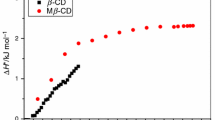Abstract
The hemolytic properties of naturalcyclodextrins, especially of the more commoncyclomaltoheptaose entity, severely hamper theirpotential use as carriers in pharmaceuticalapplications where parenteral administration isconcerned. A systematic investigation on the role ofchemical modifications with regard to the hemolyticcharacter was carried out involving C-6 branchedneutral, anionic, cationic and amphoteric derivatives.From these data, conclusions have been drawnabout the charge and the geometry of the modification: (i)Substitution at primary hydroxyl groups usuallydecreases the hemolytic character and the geometry ofthe substituent affects the hemolytic property; (ii)introduction of an amino group, resulting in apositive charge at physiological pH, decreases thehemolytic character; (iii) negative charges arecomparatively less effective in reducing the hemolyticcharacter; (iv) zwitterionic groups seem to enhancethe hemolytic character of the cyclodextrin molecule.
Similar content being viewed by others
References
Y. Okada, Y. Kubota, K. Koizumi, S. Hizukuri, T. Ohfuji and K. Ogata: Chem. Pharm. Bull. 36, 2176 (1988).
K. Uekama and T. Irie: Pharmaceutical Applications of Methylated Cyclodextrin Derivatives, in D. Duchêne (ed.), Cyclodextrins and their Industrial Uses, Editions de Santé, Paris, p. 393 (1987).
I. Jodal, P. Nanasi and J. Szejtli: Investigation of the Hemolytic Effect of the Cyclodextrin Derivatives, in O. Huber and J. Szejtli (eds.), Proc. 4th Intern. Symp. Cyclodextrins, München, 20–22 April 1988, Kluwer, Dordrecht, p. 421 (1988).
E. Leray, F. Leroy-Lechat, H. Parrot-Lopez and D. Duchêne: Supramol. Chem. 5, 149 (1995).
J. Defaye, A. Gadelle, A. Guiller, R. Darcy, R. and T. O’Sullivan: Carbohydr. Res. 192, 251 (1989).
V. Lainé, A. Coste-Sarguet, A. Gadelle, J. Defaye, B. Perly and F. Djedaïni-Pilard: J. Chem. Soc., Perkin Trans.2, 1479 (1995).
J. Defaye, B. Perly, V. Descamps, A. Coste-Sarguet and A. Gadelle: Procédé de solubilisation dans l’eau et les solvants aqueux d’agents antitumoraux et notamment du taxotère, par utilisation de cyclodextrines ramifiées, Fr. pat. FR (94) 00,778; 25 January 1994.
V. Lainé: Synthèse de dérivés monoramifiés du cyclomaltoheptaose. Etude de leurs propriétés d’inclusion par spectroscopie de résonance magnétique nucléaire: application à la solubilisation de substances d’intérêt pharmacologique, thèse de doctorat de l’Université de Grenoble, 10 May 1996.
F. Djedaïni-Pilard, J. Desalos and B. Perly: Tetrahedron Lett. 34, 2457 (1993).
F. Djedaïni-Pilard, N. Azaroual-Bellanger and B. Perly: Procédé de synthèse de dérivés ethanolamino de cyclodextrines et application à la solubilisation des composés hydrophobes, Fr. pat. FR (93) 15,472; 22 December 1993.
A. Gadelle and J. Defaye: Angew. Chem. Int. Ed. Engl. 30, 78 (1991).
T. Irie, M. Otagiri, M. Sunada, K. Uekama, Y. Ohtani, Y. Yamada and Y. Sugiyama, Y.: J. Pharm. Dyn. 5, 741 (1982).
Author information
Authors and Affiliations
Rights and permissions
About this article
Cite this article
Bost, M., Laine, V., Pilard, F. et al. The Hemolytic Properties of Chemically Modified Cyclodextrins. Journal of Inclusion Phenomena 29, 57–63 (1997). https://doi.org/10.1023/A:1007919719275
Issue Date:
DOI: https://doi.org/10.1023/A:1007919719275




